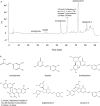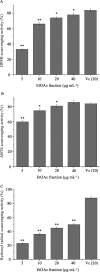Cultivated Fruit Body of Phellinus baumii: A Potentially Sustainable Antidiabetic Resource
- PMID: 32337422
- PMCID: PMC7178366
- DOI: 10.1021/acsomega.9b04478
Cultivated Fruit Body of Phellinus baumii: A Potentially Sustainable Antidiabetic Resource
Abstract
Previous studies have been reported that the fruit body of wild Phellinus baumii alleviates diabetes, and antioxidants are beneficial to diabetes by protecting the β-cell from damage due to oxidative stress. Large-scale cultivation of P. baumii fruit body has been successful in the past decade. This paper aimed to investigate whether the fruit body of the cultivated P. baumii has the same analogical effects as the wild. The cultivated P. baumii fruit body was extracted by 80% of ethanol extracts, and different fractions were obtained with the successive use of petroleum ether, ethyl acetate (EtOAc), n-butanol (n-BuOH), and water, which yielded 15.98 ± 1.56, 1.74 ± 0.34, 3.31 ± 0.41, 4.12 ± 0.37, and 1.38 ± 0.26% extract recovery, respectively. Results show that the EtOAc fraction exhibits the highest inhibitory effect on α-glucosidase activity (IC50 = 49.05 ± 3.14 μg mL-1), which is an order of magnitude higher than the positive control (acarbose, IC50 = 645.73 ± 7.86 μg mL-1). It was mainly composed of phenolic compounds with a purity of 79.45% and characterized by liquid chromatography-mass spectrometry as osmudacetone, hispidin, davallialactone, 2,5-bis(4,7-dihydroxy-8-methyl-2-oxo-2H-chromen-3-yl)cyclohexa-2,5-diene-1,4-dione, hypholomin B, and inoscavin A. Furthermore, the EtOAc fraction increased the glucose consumption of insulin-resistant HepG2 cells at a concentration range of 25-100 μg mL-1. The EtOAc fraction also demonstrated antioxidant activities by scavenging 1,1-diphenyl-2-picrylhydrazyl, 2,2'-azino-bis(3-ethylbenzothiazoline-6-sulfonic acid)diammonium salt, and hydroxyl radicals. In conclusion, the EtOAc fraction of the cultivated P. baumii fruit body exerted effective antidiabetic effects, possibly due to the high content of selective phenolic compounds. Hence, the cultivated fruit body of P. baumii can be a sustainable resource for treating diabetes, and our work also shed some light on its future utilization.
Copyright © 2020 American Chemical Society.
Conflict of interest statement
The authors declare no competing financial interest.
Figures








References
LinkOut - more resources
Full Text Sources
Miscellaneous

